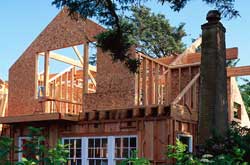Comprehensive Green Remodeling: Less Known Facts
See if We Have Top-Rated
Remodeling Professionals in Your Area

Green has become a cultural phenomenon. Like any item of pop culture, there are certain truisms that seem to make countless appearances in headlines and press releases and a whole other side that rarely, if ever, gets mentioned. Anyone into "going green" is probably familiar with such things as energy-saver light bulbs, zero-VOC paint, and bamboo, several other realities of the home construction, remodeling, and maintenance industry may play an equally big role into the other sustainable practices and green value of your home projects.
Don't Be Too Quick To Hug: Protected Trees and Tree Farms
Since of the first eco-friendly slogans and pejorative phrases for followers of sustainable living was "tree-hugging" and "tree-hugger," it might surprise some to find out that the greenest construction material for your home and your home remodeling is, often, natural wood harvested from a tree farm. All trees are not created equal. There's a big difference between California Redwoods, subtropical rainforests, and trees from your nearby tree farm. These latter trees are grown and harvested in ways that keep American construction going while protecting older, indigenous, and endangered tree species.
Pulled from the American Tree Farm System's website, the inherently green qualities of these trees can be summed up in this definition of sustainable forestry, "Sustainable forestry means managing our forests to meet the needs of the present without compromising the ability of future generations to meet their own needs by practicing a land stewardship ethic which integrates the reforestation, managing, growing, nurturing and harvesting of trees for useful products with the conservation of soil, air and water quality, wildlife and fish habitat and aesthetics." U.S. Forests Facts & Figures 2001, Clemson University and AFF
It's easy to see the difference in these types of trees, but what is, often, overlooked is that choosing wood for your home remodeling is often more eco-friendly that alternative materials. Limited supplies of aluminum, the energy it takes to manufacture synthetic materials, and the low environmental impact of these tree farms may mean that the best thing you can do for the environment is to use a tree.
Thinking about going green? We can help! Use this link for
Green Remodeling
Look in Your Own Backyard
Regardless of the material choose, regardless of the home improvement or remodel you're undertaking, one universal factor to look at and one that is frequently ignored is how far your materials have to travel to get to your home. The greater the distance the more energy is needed to transport those materials. Measuring the exact environmental impact of these transportation costs can be difficult and you certainly don't need to restrict your material selection to your own zip code, but it's definitely something to consider.
Here's one extreme, but not totally uncommon scenario: Stone tiles that cost $20 per sq. ft. instead of $5 per sq. ft. could be a sign that the tiles are traveling all over the world. In some cases, stone tile may be quarried in Brazil, shipped to China to be fabricated, and then shipped back to the States for your kitchen counter. The vast majority of the cost of this stone is eaten up by the cost of travel. The true cost of this tile affects the environment just as much as the cost of your kitchen remodel.
Keep in mind, too, that custom home remodeling doesn't necessarily have to mean customized materials. Several areas of green remodeling and construction cost more than conventional methods, but sometimes the price tag can be indicative of the environmental impact.
Green Now, Green Later: Energy Output v. Maintenance
Along with the distance a material must travel, you should take a look at its upkeep, as even basic maintenance of some installations can have an environmental impact. Take, for example, stone countertops. Engineered stone and some types of natural stone countertops don't require sealant. If you buy marble or another porous stone countertop, you may need to periodically reseal the stone with high VOC (Volatile Organic Compound) sealant or lower-quality zero-VOC sealant, but that's not the only question to ask your countertop contractor. You'll also want to ask for zero-VOC adhesive for the installation, and if you're doing things from scratch, plywood substrate free from formaldehyde.
Remember the trees? Well, residential fencing creates an interesting green remodeling debate. Aluminum and vinyl fencing may require greater energy output to install, but wood fencing not only requires sealant, but requires it every year or every other year. Unless you're diligent in buying zero-VOC sealant, wood fencing probably results in a wash. There are a number of lines of residential fencing fashioned from recycled materials such as plastic grocery bags, but you should talk to a green fencing contractor and ask how much energy is needed to reincarnate these recycled materials into viable fencing.
More Tips & Advice For Your Home
- Related Articles
- Recent Articles

